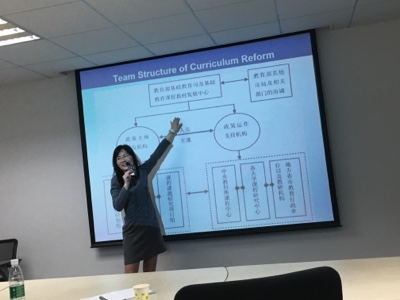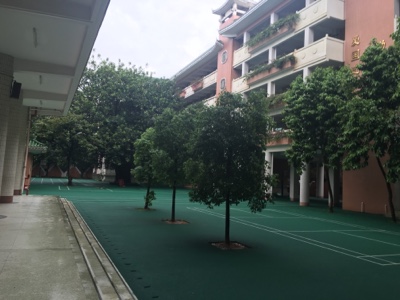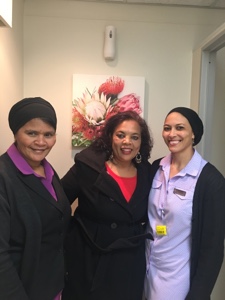Learning about the Chinese education reforms and our school visit.
This post, the fourth in the series, Ni hao (Hello) China Travelogue, covers our Day 2 in China as the South African education delegation. We were given an overview of China's educational reforms and we visited a primary school.
On a rainy, humid day we travelled from our hotel to SYSU for our second lecture entitled "The Policies and Experience of the New Curriculum Reform in China."
Here is a snapshot of that informative, interesting lecture.
We learned that China established a socialist market economy in 1992 and joined the WTO in 2001. China's population is 1,4 billion and spread over an area of over 9,6 million square kilometers. 91,5% of the population is Han while about 8,5% of Chinese belong to one of the 55 minority groups. Chinese thus has a total of 56 different groups. About 56% of the population are urbanized. There are disparities between the urban and rural population. Since 1978 China experienced radical social and economic changes.
There are about 1,600 students at this school and 118 teachers. There are 45 classes and the average class size is 45. There are about 55086 library books for children which means each child owns 33,8 books. There are about 885 reference books for teachers in the library. There are two basketball courts, six badminton courts and two tennis courts outside. They spent 200,000 yuan greening the school, planting 65 trees and rebuilding green belts around the school. Two thirds of their teachers are under 35 years old. The school recruits their teachers from the elite normal universities in China.
 |
| Dr XU Shuqin giving us an overview of China's Educational Reform |
On a rainy, humid day we travelled from our hotel to SYSU for our second lecture entitled "The Policies and Experience of the New Curriculum Reform in China."
Here is a snapshot of that informative, interesting lecture.
Background of China
Education in China
China's educational reforms started because of its aspiration for its global rejuvenation and as a response to 21st century challenges. The education system is market related to help the state develop globally competitive people.
Compulsory ( but not free) education for age 6-15 was introduced in 1985. The New Curriculum Reform moved very quickly to the implementation stage in 2011. The new new comprehensive curriculum is more balanced. In the old curriculum the focus was only on knowledge and skills whereas the new curriculum emphasizes knowledge and skills, thinking and problem solving and feelings and attitudes.
All schools, including private schools follow the national curriculum policy and must write the public examinations. The examination subjects are Ideo-morality, Chinese, Maths and Foreign language.
There are many entrance examinations that students have to write. There is an entrance examination to enter junior school, high school and higher education. Teachers need a tertiary qualification in order to teach.
 |
| Children playing boardgames |
Visit to a primary school affiliated to SYSU.
This primary school is situated on the SYSU university grounds. Our visit to the school was postponed to 14h30 because we were delayed by the rain. The school day runs from 8h00 - 12h30. Then there is a break till 14h00. Learners can sleep during this time or go home if they live close by. Teachers can also take a nap during this time or do their preparation or marking. The school day then resumes and continues till 16:30 or even 17:00.
 |
| Landie Diamond chatting to the children |
Emphasis on rest and play
When we arrived at the school, there were a number of children playing board games on the playground. Before the afternoon lessons start, the whole school does exercise. The exercise activity is announced over their intercom system. There is a huge emphasis on rest and exercise in the Chinese culture.
 |
| Teacher Felicia and I standing in front of the school library. Felicia is a mentor teacher at the school. |
We attended an open class session. These open classes are part of the professional development of teachers. One teacher would teach while her(his) peers observe the lesson to learn any new teaching tips. Each of us was given the lesson plan and we watched this young, animated teacher going through her paces.
Observing a demonstration lesson
It was sheer enjoyment to watch the teacher engaging her Grade 2 students. There were about 45 Grade 2 learners in this demonstration class. It was fascinating to see the teacher using a tour guide micro speaker. Here was a simple piece of technology that teachers can use to enable them to be audible to all their learners in their class. I could see how our teachers with their big classes can benefit from using this micro speaker, helping to save their voices and using that energy to woo their kids to learn!
Using this audio micro speaker saved the teacher from shouting and it enabled her to communicate well with all 45 learners! We were so impressed that we bought one for ourselves at the market later in the week.
The lesson was highly interactive and the flow of the lesson followed the detailed lesson plan. The teacher changed her talking pace and alternated between low and high-pitched voices. The lesson flowed from a central story theme and the activities built into the lesson included, drama, singing, questioning and choral reading. During our discussion session with the teachers, we were told that they were expected to incorporate "low voice, high voice," "slow and fast talking" and a variety of activities into their lessons. We saw these same strategies at the ZhiXin High school that we visited the next day.
A few facts about this primary school
 |
| School grounds with apartment blocks in the background. |
There are about 1,600 students at this school and 118 teachers. There are 45 classes and the average class size is 45. There are about 55086 library books for children which means each child owns 33,8 books. There are about 885 reference books for teachers in the library. There are two basketball courts, six badminton courts and two tennis courts outside. They spent 200,000 yuan greening the school, planting 65 trees and rebuilding green belts around the school. Two thirds of their teachers are under 35 years old. The school recruits their teachers from the elite normal universities in China.
The main takeaways for me were the following:
- The detailed lessons, outlining the flow of the lesson that has to incorporate the key teaching strategies pertaining to pace, voice pitch and all the senses.
- The use of the tour guide speaker as a communication tool.
- The thousands of library books where each child has access to an average of more than thirty books to read.
- The integration of rest and play into a normal school day.
- The employment of good, young teachers.
Our teachers can definitely learn from the Chinese. What do you think?






Comments
Post a Comment